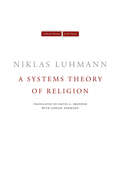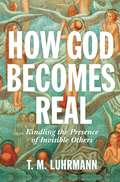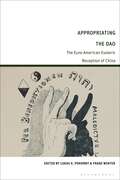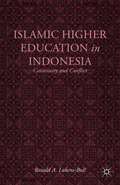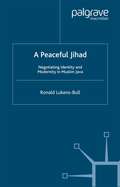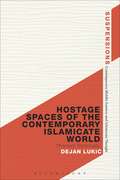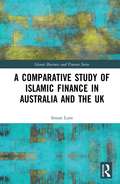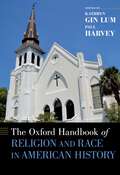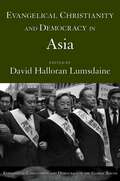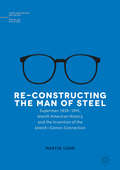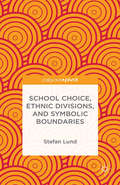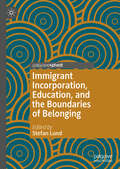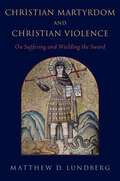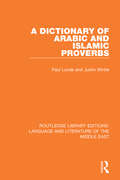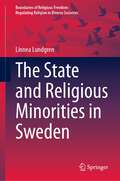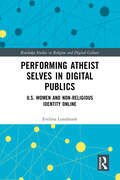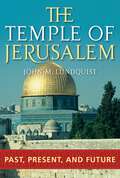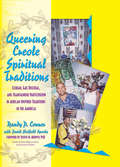- Table View
- List View
A Systems Theory of Religion (Cultural Memory in the Present #440)
by Niklas LuhmannA Systems Theory of Religion, still unfinished at Niklas Luhmann's death in 1998, was first published in German two years later thanks to the editorial work of André Kieserling. One of Luhmann's most important projects, it exemplifies his later work while redefining the subject matter of the sociology of religion. Religion, for Luhmann, is one of the many functionally differentiated social systems that make up modern society. All such subsystems consist entirely of communications and all are "autopoietic," which is to say, self-organizing and self-generating. Here, Luhmann explains how religion provides a code for coping with the complexity, opacity, and uncontrollability of our world. Religion functions to make definite the indefinite, to reconcile the immanent and the transcendent. Synthesizing approaches as disparate as the philosophy of language, historical linguistics, deconstruction, and formal systems theory/cybernetics, A Systems Theory of Religion takes on important topics that range from religion's meaning and evolution to secularization, turning decades of sociological assumptions on their head. It provides us with a fresh vocabulary and a fresh philosophical and sociological approach to one of society's most fundamental phenomena.
How God Becomes Real: Kindling the Presence of Invisible Others
by T.M. LuhrmannThe hard work required to make God real, how it changes the people who do it, and why it helps explain the enduring power of faithHow do gods and spirits come to feel vividly real to people—as if they were standing right next to them? Humans tend to see supernatural agents everywhere, as the cognitive science of religion has shown. But it isn’t easy to maintain a sense that there are invisible spirits who care about you. In How God Becomes Real, acclaimed anthropologist and scholar of religion T. M. Luhrmann argues that people must work incredibly hard to make gods real and that this effort—by changing the people who do it and giving them the benefits they seek from invisible others—helps to explain the enduring power of faith.Drawing on ethnographic studies of evangelical Christians, pagans, magicians, Zoroastrians, Black Catholics, Santeria initiates, and newly orthodox Jews, Luhrmann notes that none of these people behave as if gods and spirits are simply there. Rather, these worshippers make strenuous efforts to create a world in which invisible others matter and can become intensely present and real. The faithful accomplish this through detailed stories, absorption, the cultivation of inner senses, belief in a porous mind, strong sensory experiences, prayer, and other practices. Along the way, Luhrmann shows why faith is harder than belief, why prayer is a metacognitive activity like therapy, why becoming religious is like getting engrossed in a book, and much more.A fascinating account of why religious practices are more powerful than religious beliefs, How God Becomes Real suggests that faith is resilient not because it provides intuitions about gods and spirits—but because it changes the faithful in profound ways.
Appropriating the Dao: The Euro-American Esoteric Reception of China
by Lukas K. Pokorny and Franz WinterAssembling original contributions, this book is a pioneering attempt to address the Euro-American esoteric reception and appropriation of China.Positioned between eighteenth-century's mesmerism and intersections with the modern martial arts current, the contributions specifically centre on nineteenth and early twentieth-century occult appraisals and representations. This book opens up an under-explored area of research inthe field of East–West interactions and the global history of religions.
Holy Bible - New Testament - Part IIb Gospel According to Luke
by LukeThe Gospel of Luke, ascribed to Luke begins with parallel stories of the birth and childhood of John the Baptist and Jesus and ends with appearances of the resurrected Jesus and his ascension into heaven. It is the third book of the New Testament and contains twenty four chapters.
Islamic Higher Education in Indonesia: Continuity and Conflict
by R. Lukens-BullThis project looks at the work of the faculty in Indonesia's National Islamic Institutes to address, respond, and prevent the success of radical Islamic discourse and institution of Shari'a law in the school system.
A Peaceful Jihad: Negotiating Identity and Modernity in Muslim Java (Contemporary Anthropology of Religion)
by R. Lukens-BullBased on extensive ethnographic research, this book examines how the Islamic community in Java, Indonesia, is actively negotiating both modernity and tradition in the contexts of nation-building, globalisation, and a supposed clash of civilizations. The pesantren community, so-called because it is centered around an educational institution called the pesantren, uses education as a central arena for dealing with globalization and the construction and maintenance of an Indonesian Islamic identity. However, the community's efforts to wrestle with these issues extend beyond education into the public sphere in general and specifically in the area of leadership and politics. The case material is used to understand Muslim strategies and responses to civilizational contact and conflict. Scholars, educated readers, and advanced undergraduates interested in Islam, religious education, the construction of religious identity in the context of national politics and globalization will find this work useful.
Hostage Spaces of the Contemporary Islamicate World: Phantom Territoriality (Suspensions: Contemporary Middle Eastern and Islamicate Thought)
by Dejan LukicHow is hostage space constructed? In this age-long procedure found in conflicts around the world, strange forms of terror and intimacy arise, particularly in the contemporary Islamic cultures of Chechnya, Albania, and Bosnia. This book investigates the modes of desire and politics found in kidnapping, in order to reveal the voices of victims and kidnappers that often remain closed up. Dejan Lukic explores the spaces where hostages and hostage takers come into contact - spaces of accident, sacrifice, hope, and catastrophe - or, in other words, the spaces that announce utopias bound to fail. In this book, the figures of the victim, the terrorist, the sovereign, the resistance fighter and the witness – among others – emerge with a new face; one that will contribute to our understandings of what it means to act politically and ethically today.
Hostage Spaces of the Contemporary Islamicate World: Phantom Territoriality (Suspensions: Contemporary Middle Eastern and Islamicate Thought)
by Dejan LukicHow is hostage space constructed? In this age-long procedure found in conflicts around the world, strange forms of terror and intimacy arise, particularly in the contemporary Islamic cultures of Chechnya, Albania, and Bosnia. This book investigates the modes of desire and politics found in kidnapping, in order to reveal the voices of victims and kidnappers that often remain closed up. Dejan Lukic explores the spaces where hostages and hostage takers come into contact - spaces of accident, sacrifice, hope, and catastrophe - or, in other words, the spaces that announce utopias bound to fail. In this book, the figures of the victim, the terrorist, the sovereign, the resistance fighter and the witness – among others – emerge with a new face; one that will contribute to our understandings of what it means to act politically and ethically today.
The Official Indonesian Qurʾān Translation: The History and Politics of Al-Qur’an dan Terjemahnya (The Global Qur'an #1)
by Fadhli LukmanThis book studies the political and institutional project of Al-Qur’an dan Terjemahnya, the official translation of the Qurʾān into Indonesian by the Indonesian government. It investigates how the translation was produced and presented, and how it is read, as well as considering the implications of the state’s involvement in such a work. Lukman analyses the politicisation of the Qurʾān commentary through discussion of how the tafsīr mechanism functions in this version, weighing up the translation’s dual constraints: the growing political context, on the one hand, and the tafsīr tradition on the other. In doing so, the book pays attention to three key areas: the production phase, the textual material, and the reception of the translation by readers. This book will be of value to scholars with an interest in tafsīr studies, modern and Southeast Asian or Indonesian tafsīr sub-fields, the study of Qurʾān translations, and Indonesian politics and religion more broadly.
A Comparative Study of Islamic Finance in Australia and the UK (Islamic Business and Finance Series)
by Imran LumThis book provides valuable insights into the practical challenges faced by the nascent Islamic finance industry and compares the Australian experience to developments in the UK. It contributes to a greater understanding of how Muslims living as a minority in Australia and the UK negotiate Islamic doctrine in secular societies by focusing on one aspect of this negotiation, namely the prohibition of ribā. There is little debate in the Islamic tradition on the prohibition of ribā. The differences, however, lie in the interpretation of ribā and the question of how Muslims live in a society that is heavily reliant on interest and conventional banking, yet at the same time adhere to Islamic guidelines. Through the words of religious leaders, Muslim professionals and university students, Imran Lum provides real accounts of how Muslims in Australia and the UK practically deal with conventional banking and finance products such as home loans, savings accounts and credit cards. He also explores Muslim attitudes towards Islamic finance and queries whether religion is the sole determining factor when it comes to its uptake. Drawing on his own unique experience as a practitioner responsible for growing an Islamic business in a conventional bank, Lum provides a firsthand account of the complexities associated with structuring Islamic finance products that are not only sharia compliant but also competitive in a non-Muslim jurisdiction. Using ṣukūk bonds as a case study, he highlights the tangible and non-tangible barriers to product development, such as tax and regulatory requirements and the rise of Islamophobia. Combining academic and industry experience, Lum unpacks the relationship of Islamic finance with Muslim identity construction in the West and how certain modalities of religiosity can lead to an uptake of Islamic finance, while others can lead toits rejection.
A Comparative Study of Islamic Finance in Australia and the UK (Islamic Business and Finance Series)
by Imran LumThis book provides valuable insights into the practical challenges faced by the nascent Islamic finance industry and compares the Australian experience to developments in the UK. It contributes to a greater understanding of how Muslims living as a minority in Australia and the UK negotiate Islamic doctrine in secular societies by focusing on one aspect of this negotiation, namely the prohibition of ribā. There is little debate in the Islamic tradition on the prohibition of ribā. The differences, however, lie in the interpretation of ribā and the question of how Muslims live in a society that is heavily reliant on interest and conventional banking, yet at the same time adhere to Islamic guidelines. Through the words of religious leaders, Muslim professionals and university students, Imran Lum provides real accounts of how Muslims in Australia and the UK practically deal with conventional banking and finance products such as home loans, savings accounts and credit cards. He also explores Muslim attitudes towards Islamic finance and queries whether religion is the sole determining factor when it comes to its uptake. Drawing on his own unique experience as a practitioner responsible for growing an Islamic business in a conventional bank, Lum provides a firsthand account of the complexities associated with structuring Islamic finance products that are not only sharia compliant but also competitive in a non-Muslim jurisdiction. Using ṣukūk bonds as a case study, he highlights the tangible and non-tangible barriers to product development, such as tax and regulatory requirements and the rise of Islamophobia. Combining academic and industry experience, Lum unpacks the relationship of Islamic finance with Muslim identity construction in the West and how certain modalities of religiosity can lead to an uptake of Islamic finance, while others can lead toits rejection.
The Oxford Handbook of Religion and Race in American History (Oxford Handbooks)
by Kathryn Gin Lum Paul HarveyThe Oxford Handbook of Religion and Race in American History brings together a number of established scholars, as well as younger scholars on the rise, to provide a scholarly overview for those interested in the role of religion and race in American history. Thirty-four scholars from the fields of History, Religious Studies, Sociology, Anthropology, and more investigate the complex interdependencies of religion and race from pre-Columbian origins to the present. The volume addresses the religious experience, social realities, theologies, and sociologies of racialized groups in American religious history, as well as the ways that religious myths, institutions, and practices contributed to their racialization. Part One begins with a broad introductory survey outlining some of the major terms and explaining the intersections of race and religions in various traditions and cultures across time. Part Two provides chronologically arranged accounts of specific historical periods that follow a narrative of religion and race through four-plus centuries. Taken together, The Oxford Handbook of Religion and Race in American History provides a reliable scholarly text and resource to summarize and guide work in this subject, and to help make sense of contemporary issues and dilemmas.
Evangelical Christianity and Democracy in Asia
by David Halloran LumsdaineAlthough a minority of the Asian population, Protestants in Asia are a fast-growing group. What are the political implications of this evangelical Christianity? In some cases, religion has enabled poor and marginalized people to gain greater prosperity, self-confidence and civic skills, and more open-minded and democratic societies. But does religion have the kind of cultural currency needed to generate political changes in governments such as China's? Evangelical Christianity and Democracy in Asia provides six case studies on China, Western India, Northeast India, Indonesia, South Korea, and the Philippines. The contributors, mainly younger scholars based in Asia, bring first hand-knowledge to their chapters. The result is a groundbreaking work, indispensable to everyone concerned with the future of the region. Evangelical Christianity and Democracy in Asia is one of four volumes in the series Evangelical Christianity and Democracy in the Global South and grew from a Pew-funded study that sought to answer the question: What happens when a revivalist religion based on scriptural orthodoxy participates in the volatile politics of the Third World? At a time when the global-political impact of another revivalist and scriptural religion - Islam - fuels debate, these volumes offer an unusual comparative perspective.
Re-Constructing the Man of Steel: Superman 1938–1941, Jewish American History, and the Invention of the Jewish–Comics Connection (Contemporary Religion and Popular Culture)
by Martin LundIn this book, Martin Lund challenges contemporary claims about the original Superman’s supposed Jewishness and offers a critical re-reading of the earliest Superman comics. Engaging in critical dialogue with extant writing on the subject, Lund argues that much of recent popular and scholarly writing on Superman as a Jewish character is a product of the ethnic revival, rather than critical investigations of the past, and as such does not stand up to historical scrutiny. In place of these readings, this book offers a new understanding of the Superman created by Jerry Siegel and Joe Shuster in the mid-1930s, presenting him as an authentically Jewish American character in his own time, for good and ill.On the way to this conclusion, this book questions many popular claims about Superman, including that he is a golem, a Moses-figure, or has a Hebrew name. In place of such notions, Lund offers contextual readings of Superman as he first appeared, touching on, among other ideas, Jewish American affinities with the Roosevelt White House, the whitening effects of popular culture, Jewish gender stereotypes, and the struggles faced by Jewish Americans during the historical peak of American anti-Semitism.In this book, Lund makes a call to stem the diffusion of myth into accepted truth, stressing the importance of contextualizing the Jewish heritage of the creators of Superman. By critically taking into account historical understandings of Jewishness and the comics’ creative contexts, this book challenges reigning assumptions about Superman and other superheroes’ cultural roles, not only for the benefit of Jewish studies, but for American, Cultural, and Comics studies as a whole.
School Choice, Ethnic Divisions, and Symbolic Boundaries
by S. LundThis book enriches empirical and theoretical understandings of how school choice and school segregation are generated by the construction and negotiation of ethnic divisions by placing emphasis on feelings of belonging and we-ness as important structuring forces that guide and restrict students' school choices.
Immigrant Incorporation, Education, and the Boundaries of Belonging
by Stefan LundIn this edited volume, authors analyze how symbolic boundaries of belonging are negotiated and reflected upon by school actors in different educational contexts and how that contributes to a richer understanding of the ways in which "we-ness" acts as a fundamentally structuring force in immigrant incorporation. The analyses draw on cultural sociologist Jeffrey Alexander's work on civil sphere theory, thus grasping both the solidaristic dimensions of incorporation and processes of exclusion. Chapters are guided by two major themes: school choice/ethnic school segregation and religion/faith in schooling. Both of these themes provide rich examples of how immigrant school actors negotiate the symbolic codes that define boundaries of belonging/non-belonging in different communities. This focus will broaden the understanding of how educational practices and formal schooling works in relation to immigrant incorporation into different school cultures, as well as in the Swedish civil sphere.
Christian Martyrdom and Christian Violence: On Suffering and Wielding the Sword
by Matthew D. LundbergWhat is the place-if any-for violence in the Christian life? At the core of Christian faith is an experience of suffering violence as the price for faithfulness, of being victimized by the world's violence, from Jesus himself to martyrs who have died while following him. At the same time, Christian history had also held the opinion that there are situations when the follower of Jesus may be justified in inflicting violence on others, especially in the context of war. Do these two facets of Christian ethics and experience present a contradiction? Christian Martyrdom and Christian Violence: On Suffering and Wielding the Sword explores the tension between Christianity's historic reverence for martyrdom (suffering violence for faith) and Christianity's historical support of a just war ethic (involving the inflicting of violence). While the book considers the possibility that the two are unreconcilable, it also argues that they are ultimately compatible; but their compatibility requires a more humanized portrait of the Christian martyr as well as a stricter approach to the justified use of violence.
Christian Martyrdom and Christian Violence: On Suffering and Wielding the Sword
by Matthew D. LundbergWhat is the place-if any-for violence in the Christian life? At the core of Christian faith is an experience of suffering violence as the price for faithfulness, of being victimized by the world's violence, from Jesus himself to martyrs who have died while following him. At the same time, Christian history had also held the opinion that there are situations when the follower of Jesus may be justified in inflicting violence on others, especially in the context of war. Do these two facets of Christian ethics and experience present a contradiction? Christian Martyrdom and Christian Violence: On Suffering and Wielding the Sword explores the tension between Christianity's historic reverence for martyrdom (suffering violence for faith) and Christianity's historical support of a just war ethic (involving the inflicting of violence). While the book considers the possibility that the two are unreconcilable, it also argues that they are ultimately compatible; but their compatibility requires a more humanized portrait of the Christian martyr as well as a stricter approach to the justified use of violence.
A Dictionary of Arabic and Islamic Proverbs
by Paul Lunde Justin WintleOne of the quickest ways to understand a people or a culture is to learn their proverbs. This anthology, first published in 1984, compiles in dictionary form proverbs from the Islamic world, particularly the Middle East and North Africa. The Arabs were the first to gather and annotate their own proverbs – the earliest collections date from the n
A Dictionary of Arabic and Islamic Proverbs
by Paul Lunde Justin WintleOne of the quickest ways to understand a people or a culture is to learn their proverbs. This anthology, first published in 1984, compiles in dictionary form proverbs from the Islamic world, particularly the Middle East and North Africa. The Arabs were the first to gather and annotate their own proverbs – the earliest collections date from the n
The State and Religious Minorities in Sweden (Boundaries of Religious Freedom: Regulating Religion in Diverse Societies)
by Linnea LundgrenThis book, a revised version of Lundgren’s PhD thesis, offers a deepened understanding of the changes in the governance of religious diversity and the complex relationship between state and religion. Linnea Lundgren explores how the narrative of risk and resource came to be by looking beyond the developments in the last few decades (particularly since 9/11) and analysing how the governance of religious diversity has developed over time. In particular, she focuses on the case of Sweden that is often regarded as one of the most secular countries in the world, while simultaneously being recognised as one of the most multi-religious countries in Europe due to a rise in immigration. This book reveals how the state has had a central role in setting the terms and conditions that both enable and limit what religious communities can do, thus shaping the function and role of religion in the public realm.Through the analysis of an extensive number of government documents over a period of seventy years (1952-2022), Lundgren challenges the idea that many of the recent controversies concerning religious diversity are new. She argues that many of the discussions held today regarding the accommodation of Muslims are decidedly similar to previous discussions regarding the management of Catholics and the Free Churches in the 1950s and 1960s. She shows that the underlying fear has remained the same; that the individual’s rights can become weakened or diminished in religious communities and that religious minorities will challenge the common shared values of the society. In light of this Lundgren concludes that in order to understand what is really at stake in the debate regarding religious diversity in Sweden today, there is a need to look at underlying tensions that exist between the state, civil society and the individual, a relationship that differs considerably in the Nordic context compared to other contexts. This text appeals to students and researchers working in the sociology of religion and people who work with governance of religion, religion and civil society, and religion and law in Europe.
Performing Atheist Selves in Digital Publics: U.S. Women and Non-Religious Identity Online (Routledge Studies in Religion and Digital Culture)
by Evelina LundmarkThis book considers how the non-religious self is performed publicly online, and how digital culture and technology shapes this process. Building on a YouTube case study with women vloggers, it presents unique empirical data on non-organized atheism in the United States. Lundmark suggests that the atheist self as performed online exists in tension between a perception of atheism as sinful and amoral in relation to hegemonical Christianity in the U.S., and the hyperrational, male-centered discourse that has characterized the atheist movement. She argues that women atheist vloggers co-effect third spaces of emotive resonance that enable a precarious counterpublicness of performing atheist visibility. The volume offers a valuable contribution to the discussion of how the public, the private, and areas in-between are understood within digital religion, and opens up new space for engaging with the increased visibility of atheist identity in a mediatized society.
Performing Atheist Selves in Digital Publics: U.S. Women and Non-Religious Identity Online (Routledge Studies in Religion and Digital Culture)
by Evelina LundmarkThis book considers how the non-religious self is performed publicly online, and how digital culture and technology shapes this process. Building on a YouTube case study with women vloggers, it presents unique empirical data on non-organized atheism in the United States. Lundmark suggests that the atheist self as performed online exists in tension between a perception of atheism as sinful and amoral in relation to hegemonical Christianity in the U.S., and the hyperrational, male-centered discourse that has characterized the atheist movement. She argues that women atheist vloggers co-effect third spaces of emotive resonance that enable a precarious counterpublicness of performing atheist visibility. The volume offers a valuable contribution to the discussion of how the public, the private, and areas in-between are understood within digital religion, and opens up new space for engaging with the increased visibility of atheist identity in a mediatized society.
The Temple of Jerusalem: Past, Present, and Future
by John M. LundquistAs war and terrorism continue to rage over the Holy Land, the Temple of Jerusalem, arguably the most famous sacred structure in world history, looms in the background as a symbol of past glory, a place of religious worship, and a site to be contended over and coveted. This book offers a general history of the meaning, importance, and significance of the Temple of Jerusalem, in both the religious and the political arena. It begins with the construction of the Temple, its destruction in 587 B.C.E., its reconstruction in 516 B.C.E., the vast enlargement during the time of the Idumean King Herod, around 20 B.C.E., its final destruction in 70 C.E., and its dynamic and abundant afterlife as the leading influence in the construction of Jewish synagogues, Christian cathedrals, and Islamic mosques. But the Temple has also been at the center of much political and religious controversy, and Lundquist explores the issues and conflicts that have erupted over this sacred place, considers the meaning and importance of the Temple to Christianity, Judaism and Islam, from ancient times to the present, and concludes with a careful consideration of the continuing religious and political tensions.On September 28, 2000, Ariel Sharon visited the Temple Mount (also called Al-Haram As-Sharif) in Jerusalem, igniting what has come to be known as the second intifada. But why would such a visit to a religious site set off such a string of violent responses that continue to this day? The answer lies in the history of the Temple of Jerusalem, which once, indeed twice, stood in the spot known today as the Temple Mount (to Jews) and the Dome of the Rock (to Muslims). A holy place to three of the world's main religions—Christianity, Judaism, and Islam—the Temple of Jerusalem is, arguably, the most famous sacred structure in world history and figures prominently in Apocalyptic writings. Yet, it is almost entirely absent, in all its phases, from the archaeological record, as the sacred nature of the site prohibits any excavation.
Queering Creole Spiritual Traditions: Lesbian, Gay, Bisexual, and Transgender Participation in African-Inspired Traditions in the Americas
by Randy P Lundschien Conner David SparksWhat roles do queer and transgender people play in the African diasporic religions? Queering Creole Spiritual Traditions: Lesbian, Gay, Bisexual, and Transgender Participation in African-Inspired Traditions in the Americas is a groundbreaking scholarly exploration of this long-neglected subject. It offers clear insight into the complex dynamics of gender and sexual orientation, humans and deities, and race and ethnicity, within these richly nuanced spiritual practices. Queering Creole Spiritual Traditions explores the ways in which gender complexity and same-sex intimacy are integral to the primary beliefs and practices of these faiths. It begins with a comprehensive overview of Vodou, Santeria, and other African-based religions. The second section includes extensive, revealing interviews with practitioners who offer insight into the intersection of their beliefs, their sexual orientation, and their gender identity. Finally, it provides a powerful analysis of the ways these traditions have inspired artists, musicians, and writers such as Audre Lorde, as well as informative interviews with the artists themselves. In Queering Creole Spiritual Traditions, you will discover: how the presence of androgynous divinities affects both faith and practice in Vodou, Candomble, Santeria, and other Creole religions how the phenomenon of possession or embodiment by a god or goddess may validate queer identity and nurture gender complexity who practices the African-derived spiritual traditions, what they believe, and who their deities are how these faiths have influenced the art and aesthetic traditions of the West This landmark book opens a fascinating new world of thought and belief. The authors provide rigorous documentation and faultless scholarly method as well as personal experience and the testimony of believers. Queering Creole Spiritual Traditions sheds new light on two widely different fields: LGBT studies and the theology of the African diaspora. A thorough bibliography points the way to further study, and an extensive photograph gallery provides a unique look at the believers and their practices. Every library with holdings in queer theory, African mythology, or sociology of religion should have this landmark volume.
